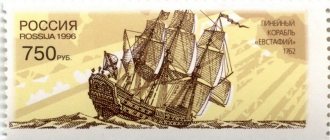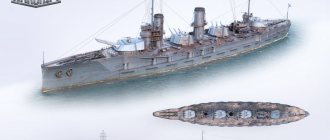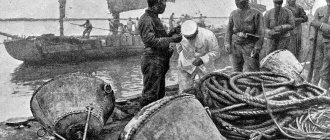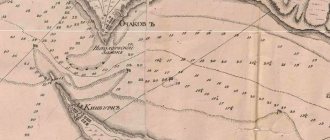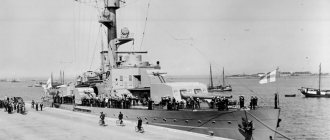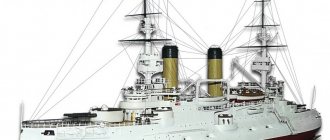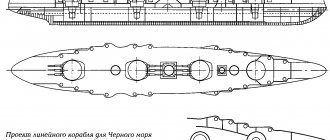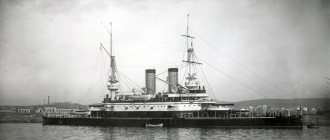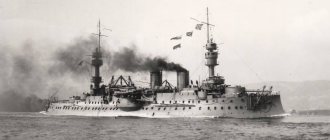Home » Alternative shipbuilding - Fleets that never existed » Squadron battleships of the "Andrey Pervozvanny" type (Eagles of the Fatherland)
Alternative shipbuilding - Fleets that never existedAlternative shipbuilding - Fleets that never existed
arturpraetor 03/25/2020 2799
14
in Favoritesin Favoritesfrom Favorites 9
Good day, colleagues. For the sake of variety, I should update myself with “Eagles of the Fatherland,” otherwise I’ll think that I’ve completely abandoned this topic. There are actually a lot of ship options for publication, but I decided to choose one and only one, and I would say a unique ship. We will talk about alternative (but not very) battleships of the “Andrew the First-Called” type .
Characteristics of battleships of the "Andrey Pervozvanny" class
A country:RussiaType:Squadron battleship (battleship)Date of issue:08/3/1903 was included in the list of ships of the Baltic Fleet, 05/11/1905 was laid down, 10/20/1906 was launched, 05/13/1912 entered serviceDisplacement:18580 tonsLength:140.21 m.Width:24.34 mDraft:8.53 mReservations:main armor belt: 79-216 mm, mine artillery casemates - 127 mm, main caliber turrets: 63.5-254 mm, medium caliber turrets from 50.8-177.8 mm, conning tower: 102-203 mm, lower armor deck - 39.6 mm, bevels - 38.1 mm, upper deck - 31.7 mmCrew:31 officers, 26 conductors, 900 lower ranks.Power point:2 vertical triple expansion steam engines with a total power of 17,600 hp. (contract), 3 screws Travel range:2100 miles economical (12 knots) speedMaximum speed:18 knots (contractual, in reality 18.5 knots)Weapons:2x 2x 305mm long 40 calibers (max. range 110 cable, 70 shots per gun), 4x 2x 203mm long 50 calibers (max. range 95 cable, 110 shots per gun), 6x 1x 203mm long 50 calibers (max. distance 95 cable , 110 rounds per gun), 12x 1x 120mm long 45 calibers (max. range 65 cable, 200 shots per gun), 2x 1x 47-mm salute guns, 6x 1x 7.62-mm machine guns, 2 underwater 457-mm torpedo tubes (6 torpedoes each), 2 searchlights with a diameter of 90 cmAir group:No
“The last and best battleships of the Russian fleet. History of creation, design features and details of combat service"
Characteristics are given for the battleship "Andrew the First-Called"
The last battleships of Russia. Ships of the "Andrey Pervozvanny" and "Eustathius" types
The lessons of the war forced adjustments to be made to the design and armament of these ships, originally conceived as a further development of the Borodino, but with increased displacement and reinforced armament. After Tsushima, the construction of battleships was suspended and they decided to redesign them. One version of change followed another; In total, we considered 17 options (!) of new projects until both shipbuilders and sailors were satisfied. Russian designers created an almost ideal ship, but for the times of Tsushima. The booking was especially impressive. It was hardly possible to find anywhere a battleship whose armor covered over 95% of the freeboard area! But it is impossible to improve absolutely all characteristics without sacrificing anything. As a result of the large armor area, its thickness suffered. Even the main belt of "Andrei" and "Paul" provided poor protection against twelve-inch shells at most combat distances. Since their construction dragged on for more than eight years, the result was disastrous. In 1912, when they entered service, both battleships turned out to be completely outdated compared to the dreadnoughts. The battleship's displacement was 18,590 tons, length - 140.2 m, width - 24.4 m, draft - 8.5 m, crew: 31 officers, 26 conductors and 900 lower ranks. Power plant: two vertical triple expansion engines, 25 Belleville boilers, power - 17,635 hp. s., speed - 18.5 knots, cruising range - 2,100 miles. Armament: 4 × 305 mm, 14 × 203 mm, 12 × 120 mm, 4 × 47 mm guns, 6 × 10.67 mm Maxim machine guns, four 457 mm TA. Reservations: main belt of Krupp armor - 79...216 mm, medium artillery casemates - 127 mm, main caliber turrets - 63.5...254 mm, medium caliber turrets - 50.8...177.8 mm, conning tower - 102...203 mm , lower armor deck - 39.6 mm, bevels - 38.1 mm, upper deck - 31.7 mm.
Battleship "Andrew the First-Called", 1912
The ship's hull was made of sheet and profiled Siemens-Martin steel by riveting and assembled using a bracket system. The ship had a smooth upper armored deck and two more full armored decks (middle and lower), a double bottom, horizontal and vertical keels, fore and stern posts. The stem and sternpost, which formed the bow and stern ends, were made of steel castings. On the residential (middle) G deck there were wardrooms for officers and conductors, living quarters for command personnel, turret spaces of the main caliber towers, a dressing station and a pharmacy, an office, and crew quarters. On the lower deck there were provisions rooms, a wine cellar, a capstan, a steering engine room, a dynamo room, heating pads, engine and boiler room casings, a central combat post, dry provisions rooms, and a skipper's room. In the hold there were ammunition cellars, compartments for bilge pumps and pumps, and coal pits. The double bottom was divided by floors and stringers into independent compartments and was located from the 13th to the 99th frames. Transverse watertight bulkheads were located on the 4th, 13th, 15th, 18th, 24th, 28th, 34th, 40th, 46th, 50th, 56th, 58th -m, 62nd, 68th, 73rd, 86th, 90th and 99th frames. The battleship had two side longitudinal bulkheads, which were installed 2.5 meters from the sides along the length from the 28th to the 86th frames, and served as additional mine protection for the ship. The main feature of the ship's silhouette was the presence of two openwork American-type masts with observation posts. Their height was unusually large and amounted to 53.4 m. When testing the new battleships, poor seaworthiness was revealed - the ship buried itself in the water, taking a lot of water onto the forecastle.
Diagram of the general arrangement of the battleship of the “Andrei Pervozvanny” type: a—side view, b—top view
Very important changes took place in artillery. Although the 12-inch guns remained the same, they were equipped with new bolts that shortened the interval between shots. The guns were located in two rotating turrets in the bow and stern. Based on war experience, it became clear that 152 mm guns were weak to inflict serious damage on battleships. Therefore, the average caliber was 8-inch (203 mm) with a barrel length of 50 calibers, developed by . Eight of them were installed in four side rotating turrets in the bow and stern, and six more (three pieces on each side) in the lower casemate (on the Metal Plant machine, on the central pin). The mine attacks were to be repelled by twelve 120-mm Kane guns with a barrel length of 45 calibers, located on the sides in the upper casemate. Four single-barreled 47-mm Hotchkiss cannons with a barrel length of 43.5 calibers were intended for fireworks. Six single-barrel 10.67-mm machine guns of the Maxim system with a barrel length of 67.6 calibers were intended for placement in boats (4) and for landing (2).
The main side belt, 3.06 m high in the middle part, of which 1.22 m went under water, consisted of 216 mm armor plates; towards the lower edge it thinned to 152 mm, towards the bow - up to 127 mm, towards the stern - up to 102 mm. The upper belt, with an average height of 2.66 m, had a thickness of 127...102 mm, at the ends - 79 mm. The casemates of the 203-mm and 120-mm guns were protected by 127-mm armor on the sides, 102-mm along the traverses, and the bulkheads between these guns were 38 and 25.4 mm thick, respectively. There was not a single porthole in the hull: the designers decided not to weaken the armor plates. The horizontal armor consisted of lower and middle armor, upper and hinged (aka the roof of the casemates of 203 mm guns) decks. 24 mm armor plates were laid on the lower deck from frames 34 to 90, and 22 mm armor plates were laid at the ends. The middle deck between the side corridors was assembled from 25 mm armor plates, and 38...31 mm plates were laid on its 22 mm flooring above the side corridors. The upper deck within the casemate had a thickness of 6.4 mm, and outside it, taking into account the armor, 32 mm. The hanging deck and roof of the casemate of the 120 mm guns were protected by 19 mm sheets. Only a small area in the upper part of the stern had no protection. The main gun turrets were armored with slabs 203 mm thick for the front and side walls, 254 mm for the rear wall (also known as the counterweight), and 63.5 mm for the roof. The turrets of the 203 mm guns had a thickness of the front and rear walls of 152 mm, the side walls - 127 mm, and the roof - 50.8 mm.
The power plant consisted of two steam four-cylinder triple expansion engines of 8,816 liters each. s, driving two three-bladed propellers with a diameter of 5.6 m. Steam was produced by 25 Belleville boilers, which were located in five boiler rooms. In addition to the main ones, the battleship also had auxiliary boilers. The full supply of fuel (coal) included 1,000 tons, which allowed the battleship to travel about 2,100 miles at a speed of 10 knots. and 1,300 miles at a speed of 16 knots.
"Andrew the First-Called" Laid down on April 28, 1905 at the Galerny Island shipyard of the Admiralty Plant, launched on October 7, 1906, officially put into operation on April 30, 1912. On February 25, 1911, “Andrew the First-Called” and “Emperor Paul I” were enrolled in the active fleet . But for another year and a half, the delivery of individual auxiliary mechanisms, systems, and equipment continued, as well as the elimination of deficiencies identified during testing. From August 28 to September 21, 1912, the ship, which was part of the Baltic Sea squadron, passed through Copenhagen, Portland, Brest, Stavanger (Norway), with a return to Revel. This was the first and last campaign of the squadron battleship. He took part in the First World War, the beginning of which he met in the dock, covered the raiding actions of the light forces of the fleet, but only accomplished
Main caliber turret of the battleship "Andrei Pervozvanny"
On November 7, 1917 it became part of the Red Baltic Fleet. On April 5–10, 1918 he made the transition from Helsingfors to Kronstadt. Participated in the civil war, during the suppression of the uprising at the Krasnaya Gorka fort on July 13–15, 1919, fired one hundred seventy 305 mm and four hundred eight 203 mm shells. Then he was part of the active detachment of ships. On August 18, 1919, during an attack on Kronstadt by English torpedo boats, the Andrei Pervozvanny was hit by a torpedo in the bow of the port side, creating a hole about 11 m long and up to 9.1 m high. After this, the battleship was sent for restoration repairs. In the conditions of post-revolutionary devastation, it was not restored and on February 8, 1924 it was excluded from the lists of ships of the Naval Forces of the Baltic Sea. At the same time, 203-mm turret mounts were installed at the Krasnoflotsky and Pervomaisky forts, and 305-mm gun mounts were used on the TM-2-12 railway artillery transporters.
Medium-caliber artillery casemate of the battleship "Andrei Pervozvanny"
"Emperor Paul I". Laid down in the boathouse of the Baltic Shipyard on October 25, 1905, launched on September 7, 1907. On October 20, 1910, the final stage of testing began: the ship passed an eight-hour test at full speed, was put into operation on March 10, 1911, but was still being repaired for a long time imperfections. On July 16, 1911, “Emperor Paul I” was enlisted in the Baltic Sea battleship brigade formed at the beginning of the year. It also included the battleships “Tsesarevich”, “Slava” and “Andrew the First-Called”. In 1913, as part of a brigade of battleships, he made a trip to Portland and Brest. After the outbreak of the First World War on July 18, 1914, it provided cover for a detachment of minelayers when laying mines at the central mine-artillery position. Then, during the war, the ship remained in bases, occasionally making transitions from one to another, which, against the backdrop of the deteriorating political situation in the country, negatively affected the mood of the crew. The ship's habitability was very poor. During the design, it was decided to reduce the superstructure to a minimum, which led to problems when the crew increased to 950 people. The situation was aggravated by poor ventilation of the interior. Therefore, during the February Revolution of 1917, when some officers of the Baltic Fleet became victims of sailors, it was the personnel of “Pavel” who distinguished themselves by the greatest activity in this matter. To avoid capture by the Germans, on April 5–10, 1918, “Emperor Paul I” (from April 16, 1917 - “Republic”) made the famous transition from Helsingfors to Kronstadt. On May 16, it, along with the Andrei and four dreadnoughts, was included in the Kronstadt Naval Forces, but on September 9, due to a huge shortage of crew, the Republic was put into storage at the port. The ship was no longer put into service - on November 22, 1923 it was handed over for dismantling and cutting into metal.
Battleships of the Andrei Pervozvanny class became the last battleships built by the Russian fleet. The experience of their design and construction subsequently allowed Russian shipbuilders and the shipbuilding industry to move on to the creation of dreadnoughts of the Sevastopol type.
Reservation scheme for the Andrei Pervozvanny-class battleship
Damage to the "St. Andrew the First-Called" by a British torpedo
The Ministry of Finance agreed to allocate only 12 million rubles for new orders in 1903. The same allocations were approved for 1904. The allocated funds were primarily intended for the construction of four squadron battleships - two units each for the Baltic and Black Seas. Initial intentions to carry out a project following the example of the Baltic on the Borodino base were not realized, and therefore for the Black Sea it was recommended to repeat the Prince Potemkin-Tavrichesky project under construction, believing that this theater did not need high seaworthiness, in addition, in the Turkish The fleet (a potential enemy of Russia) does not even have such ships. Medium-caliber reinforcements were also approved. It was decided to place 203 mm guns in the lower casemates instead of the four corner 152 mm guns. The new battleships were named "Eustathius" and "John Chrysostom".
The experience of the Russo-Japanese War forced us to re-evaluate the basic combat elements. However, the hulls of the ships, which were almost completely formed by this time, no longer made it possible to introduce fundamental innovations into their design, but the adoption of a number of significant amendments to the project would have made it possible to significantly improve the tactical and technical elements of the battleships. For example, it was planned to significantly increase the ship's combat capabilities by replacing all twelve 152-mm guns on the battery deck with six 203-mm guns and increasing the number of 75-mm guns to twenty (there was also the option of replacing them with five 120-mm guns). However, due to the need for major alterations in the hulls, which would slow down the progress of construction, and also out of fear for a possible overload of more than 100 tons, the command of the Black Sea Fleet did not dare to implement this plan.
Displacement: normal 12,738 tons, full 13,780 tons, length 118.0 m, beam 22.55 m, draft 8.23 m, crew 28/20/880 people (officers/conductors/sailors). Mechanism design/test power: 10600/10808.4 indicator hp. With. (and. hp), design/maximum speed - 16/16.5 knots, cruising range - 2000 miles (10 knots), full/reinforced coal reserve - 1000/1100 tons. Reservation: side belt - 229/76.2/50.8 mm, deck - 38/76 mm, main gun turrets (front, side, rear/roof) - 254/50.8 mm; conning tower - 203 mm. Armament: 4 × 305 mm, 4 × 203 mm, 12 × 152 mm guns, 14 × 75 mm cannons, 4 × 10.67 mm machine guns, two 456 mm torpedo tubes.
Battleships "Andrew the First-Called" and "Emperor Paul I" in the database
The project almost completely repeated the prototype, but had a more advanced design of the conning tower and armor protection system for mine artillery. The hull of the battleship was made of sheet and profiled steel by riveting and assembled using a transverse casting system. Steel was supplied by Izhora, Dnepropetrovsk and other Russian factories. The ship had a forecastle, upper, living and lower (armored) decks and platforms, a double bottom, a horizontal keel, fore- and sternposts; the extension of the forecastle was a two-tier superstructure, which, together with the forecastle, accounted for up to 80% of the length of the ship. The fore- and sternposts were cast according to models from the squadron battleship “Prince Potemkin-Tavrichesky” at the Ekaterinoslav iron and steel plants. Unsinkability was ensured by dividing the hull by transverse waterproof bulkheads into 10 main compartments. The ships had longitudinal waterproof bulkheads and a double bottom from frames 18 to 82; there were also two side longitudinal bulkheads, which were installed 1.7 m from the sides and served as additional mine protection. In the area of the boiler rooms and engine compartments, along the center plane, there was a longitudinal bulkhead, which divided the compartments into two equal parts of the left and right sides. The question of the number of masts was repeatedly raised at various levels, in the end they settled on two masts - as more convenient for giving signals, and also due to the need to have observation platforms on their tops when shooting at long distances. A noticeable difference between the new ships and their prototype “Panteleimon” (as the “Prince Potemkin Tauride” began to be called on September 29, 1905) was the absence of high and wide ventilation funnels; they were replaced by mushroom-shaped air intakes, which were widely used abroad at that time, and cut there are windows on the sides of the boiler casings.
Battleship "Emperor Paul I" after commissioning
The ship's armor protection system consisted of a main belt along the waterline, an upper belt, gun casemates, 305-mm main caliber turrets and conning towers. The thickness of the main armor belt along the waterline was 229 mm in the middle part of the hull, decreasing to 203 mm in the area of the main caliber turrets. The main armor belt dropped 1.22 meters below the waterline. The bow traverse, 178 mm thick, ran along the 14th frame, and the stern beam of the same thickness ran along the 91st frame. The armor at the bow ranged from 178 to 76.2 mm, and at the stern - up to 50.8 mm. The upper armor belt consisted of 152 mm plates, which ended in the same armored traverses. The armor plates of the upper belt were made up to the height of the upper deck. The lower casemate of the 152 mm guns had armor plates 127 mm thick along the sides. To protect the casemates from longitudinal fire, 127-mm armor traverse plates were installed. Between the guns, in the casemate, armored traverses were placed, and an internal armored fence 38.1 mm thick was installed, separating the guns on the right and left sides. The upper casemate of the 203-mm and 75-mm guns, in the spardeck, along the sides had a thickness of armor plates of 76.2 mm in the area of the second and third chimneys, decreasing towards the stern to 25.4 mm and increasing towards the bow to 127 mm. On top of the upper casemate, on the spardeck deck, armor plates 25.4 mm thick were laid, which were covered with pine boards on top. We also armored the area of the tiller compartment from the platform to the lower deck with 24.5 mm plates below the waterline. The main caliber turrets had armor 254 mm thick, and were covered on top with armor 50.8 mm thick. In addition, 76.2 mm side armor was introduced for the central battery of 75 mm guns located in the spardeck. The cabins were covered with 203 mm of armor, and their roofs were covered with armor plates 76.2 mm thick. The spar deck and the top deck above the casemates of 152 mm guns (with the exception of the area of the 203 mm casemates) and the battery deck had a thickness of 25.4 mm. The living deck in the horizontal part/on the slopes is 25–70/22–76.2 mm, carapace (at the bow) is 60.3 mm. Armor for ships was manufactured by Izhora, Obukhov and partly Putilov and Metal (tower armor) factories.
Battleship "Eustathius" in dock
The main caliber was four 305-mm guns of 40 calibers, which were mounted in twin-gun turrets located fore and aft, with a firing sector of 270°. Four 203-mm 50-caliber guns from the Obukhov plant were located on the sides in the bow and stern of the upper casemate, which provided good firepower directly ahead or at the stern of the ship. It was assumed that this placement of guns would be useful when operating in the narrows of the Bosphorus against coastal fortifications. Each gun was mounted in a single-gun installation in a casemate with a firing angle of 120°. Twelve 152-mm guns of 45 Kane calibers stood in the lower casemate, their firing angle was 100°. Fourteen 75-mm Kane guns of 50 calibers (since the spring of 1914 were gradually removed) were installed on single-gun mounts, eight of which were in the upper casemate on the side, two more mounts were in the bow under the forecastle and four on the spardeck. The guns on the spardeck were protected by 12 mm thick armor shields. Four Maxim machine guns were mounted side by side on the wings of the bridge. The artillery was supplemented by two 457 mm onboard underwater torpedo tubes (removed in June 1915). Additionally installed during the war, but removed in May-June 1916, were three 75-mm anti-aircraft guns with an elevation angle of 51°. Instead, in October-November 1916, two 63.5 mm (on the towers) and 40 mm (75 mm on the John Chrysostom) anti-aircraft guns were installed.
Diagram of the general arrangement of the Eustathius-class battleship
The power plant was equipped with two three-cylinder triple expansion steam engines, produced by the Society of Shipbuilding, Mechanical and Foundry Plants in Nikolaev, with a design capacity of 5,300 and. l. With. each (total power 10,600 hp) at a propeller shaft speed of 82 rpm, driving two four-blade propellers with a diameter of 5.18 m. The propellers were made of gun metal (an alloy of red copper with tin and a small amount of zinc). Steam was produced by 22 Belleville water-tube boilers (operating steam pressure 17 kgf/cm²), located in three boiler rooms. Power supply was provided by four steam dynamos of 150 kW each and two of 64 kW each, made at the plant of the Society of Shipbuilding Mechanical and Foundry Plants in Nikolaev. "Eustathius" at a measured mile developed an average speed of 16.1 knots. with a machine power of 10,808.4 and. l. pp., “John Chrysostom” - 16.2 knots. at 10,990 and. l. With.
"Eustathius" on the move
Construction of the Eustathius began on March 11, 1904, and the official laying ceremonies of the battleship took place on October 31 and November 10, 1904. At first, the construction of the ship proceeded quite quickly, but then the pace of construction noticeably weakened. The events of the first Russian revolution also played a significant role in delaying the ship’s readiness, especially in terms of armament. Launched on October 21, 1906, sea trials of the ship began on August 17, 1910. But the armament work was far from going well; all installed 152-mm guns lacked sights, as did the 75-mm guns, for which the last three machines were still expected. For the same reason, only one of the 203 mm guns was installed on the ship. Tests of the Eustathia artillery weapons began on May 3, 1911; they showed some shortcomings that were eliminated during the tests. The ship entered service on May 15, 1911, and on July 29 it was assigned to the formed brigade of battleships, which also included Ioann, Panteleimon and Rostislav. On August 9, 1912, “Eustathius” as part of the brigade went on a long campaign, visiting Trebizond (Trabzon), Samsun, Sinop, Penderaklia (Eregli), Inada (Igneada), Burgas and Varna. The next - September - overseas campaign of Russian ships turned out to be unsuccessful for the Eustathius. On September 19, leaving the roadstead of Constanta, the ship, following in the wake of the Panteleimon, found itself aground along with it, but managed to get off it on its own.
Eustathius entered the First World War as the flagship of the Black Sea Fleet. The meeting with the German-Turkish battle cruiser Goeben and the light cruiser Breslau took place on November 18 (5), 1914 at Cape Sarych. The short battle that followed (for about 14 minutes) was reduced mainly to a duel between the flagship ships. At the very beginning, the Goeben was hit on the port side near the foremast. Following the flagship, which fired 16 305 mm, 14 203 mm and 19 152 mm shells during the battle, the “John Chrysostom” opened fire, and then the “Three Saints”. Having received a number of hits[1], the Goeben began to retreat and disappeared from sight in light fog and smoke.
"Goeben" with its shooting damaged the foresail on the "Eustathia", the radio antenna on the left side and pierced the middle chimney. A shell that exploded above the deck with shrapnel damaged two barge davits, a motor boat and the port distinctive light, riddled not only the plating of the unarmored side in the area of the conductor's quarters, but also destroyed a bulkhead and a door in one of the cabins on the opposite side. The second hit was in the right bow 152-mm casemate. The explosion destroyed all the servants - 10 people - of one of the guns, the plutong commander, partially killing and wounding the supply servants. One corner armor plate was torn off and fell onto the side of the side, and the corner of the other was torn out. The deck and side in this area were bent outward and torn apart, and one of the plates of the armored beam was pushed into the bathhouse by the explosion. The scattered fragments caused a lot of damage, 152-mm cartridges and the ship's church caught fire from the hot gases, but the fire was quickly extinguished by the servants of the guns on the opposite side. The next hit was in the casemate of the 152-mm battery - in the area of the 54th frame. Having pierced the 127-mm armor, the 280-mm shell left an almost perfect round hole in it, and the fragments that scattered all the way to the left side and even got into the boiler rooms caused numerous destructions and caused casualties. According to the Russian Naval General Staff, 33 people were killed on the Eustathia (of which 4 were officers) and 25 were wounded (1), of which 19 were seriously injured.
Reservation scheme for the Eustathius-class battleship
Repairing battle damage after the battle did not take much time. The last meeting of “Eustathius” and “John Chrysostom” with the battle cruiser “Goeben” took place on April 27, 1915 near the Bosporus. Taking advantage of the fact that “Panteleimon” and “Three Saints” separated from the main forces that were shelling the coast, “Goeben” went on the attack. The commander of the Black Sea Naval Forces, Admiral Andrei Avgustovich Ebergard (1856–1919), who led the squadron, immediately ordered a connection with the Panteleimon, while transferring the fire to the enemy. After “Eustathius” and “John Chrysostom” fired two salvos at “Goeben”, they hit him three times. Having received these hits, the Goeben went towards the Bosphorus. During the battle, “Eustathius” fired 60 shots from 305 mm and 32 from 203 mm guns, “John Chrysostom” - 75 and 4, respectively.
"Eustathius" aground near Constanta"
Damage to the casemate of the 152 mm Eustathia guns
With the entry into service of the battleships Empress Maria and Empress Catherine the Great, having given way to new dreadnoughts in the fight against the battle cruiser Goeben, Eustathius began to be used to solve other problems. He blocked the Bosphorus, supported the landing operation in Trebizond, and shelled coal mines in Zonguldak. The Black Sea Fleet made its last military campaign on October 19–23, 1917. As a result of the signed Treaty of Brest-Litovsk, the condition of which was the surrender of Sevastopol, the Goeben entered the main base of the fleet as a winner, and the Kaiser’s flags were raised on the battleships frozen in the South Bay. True, the old battleships no longer went to sea - neither under the Germans, nor under the British. The Eustathius crew managed to remove and hide the gun locks. Then the ships fell into the hands of Russia’s “allies” in the Entente, who, leaving Sevastopol in April 1919, ordered the cylinders of steam engines on Russian ships to be blown up, which predetermined the future fate of the former battleships. After the occupation of Sevastopol by units of the Red Army, an attempt was made to restore a number of ships. The Nikolaev factories were instructed to cast new cylinders for “Eustathius” (from July 6, 1921 - “Revolution”), but the devastation that reigned in Soviet Russia after the cataclysms that befell it, the lack of specialists and the required number of qualified workers made these plans unfeasible. Plans to use ships as floating batteries, with the subsequent transfer of gun turrets to coastal batteries by 1926, also turned out to be unrealistic. However, after the dismantling of the weapons, it was transferred to the jurisdiction of coastal defense. The ship itself in 1922–1923. dismantled for metal.
"John Chrysostom". Laid down on November 13, 1904 at the boathouse of the Lazarevsky Admiralty in Sevastopol, launched on May 1, 1906. On July 13, 1910, “John Chrysostom” went out for its first eight-hour test of the machines. With a displacement of 12,855 tons and a deepening to an even keel of 8.23 m, the average speed with a power plant power of 10,623.1 and. l. With. amounted to 16.2 knots. (mechanical log 17 knots). The operation of the mechanisms was considered satisfactory. On November 16, “John Chrysostom” with the selection committee on board went to sea for the last time for a 4-hour test to check at full speed the correct assembly of the mechanisms (after an inspection of their parts) and the steam production of the boilers. The power of steam engines during this test turned out to be 10,990 and. l. With. During its service, the greatest speed achieved by “John Chrysostom” was 17.05 knots. during a 10-hour run on June 23–24, 1914. The ship entered service on April 1, 1911, and on August 11, together with the battleships Panteleimon, Eustathius and Rostislav, it formed a brigade of Black Sea battleships. In 1911, the upper navigation bridge was dismantled, and the main bow compass was moved to the forward conning tower. The brigade was significantly superior to the existing fleet of the main enemy on the Black Sea (Turkey), which had three completely outdated battleships. On August 9, 1912, the full brigade of battleships and the cruisers “Kahul” (formerly “Ochakov”) and “Memory of Mercury” (formerly “Kahul”), accompanied by two divisions of destroyers, set off on a cruise. In September the brigade made a visit to Constanta.
Battleship "John Chrysostom" under construction
"John Chrysostom" on the roadstead of Sevastopol
Participated in the First World War. With its start, six 75 mm guns were removed from the spardeck in order to replace them with four 152 mm guns, and then with 203 mm guns. But due to the shortage of such weapons that arose in connection with the fighting, these plans were abandoned. In 1916, all 75 mm guns were removed from the ship. He took part in the battle against the battle cruiser Goeben at Cape Sarych. From March 28 to May 10, 1915, the Russian fleet bombarded the Bosphorus four times. At the same time, two battleships fired at the coastal fortifications, and three provided cover from the sea. On May 10, “Goeben” attacked the ships “Eustathius”, “John Chrysostom” and “Rostislav”, which were in cover. The shootout itself lasted only 23 minutes. The German-Turkish battle cruiser was hit by three 305 mm shells. In September 1915, after the commissioning of the Empress Maria-class battleships, he became part of the 2nd Battleship Brigade of the Black Sea Fleet and switched to supporting the ground forces. Participated in the shelling of the coast and ports of Zunguldak, Kilimli, Kozlu and Varna, and in operations on enemy communications. Covered military transportation and mine-laying
Battleship John Chrysostom at dock. Sevastopol, 1916
On December 29, 1917 it became part of the Red Black Sea Fleet. Since March 1918, he was in storage in the Battleship "John Chrysostom" in the construction of "John Chrysostom" in the Sevastopol roadstead of the Sevastopol military port, where on May 1, 1918 he was captured by the German occupiers, and on November 24, 1918 by the Anglo-French interventionists, and on April 22–24, 1919, by order of the British command, it was blown up and put out of action. On April 29, 1919, Sevastopol was liberated by units of the Ukrainian Front of the Red Army, but on June 24, 1919, it was captured by the White Guards. After the capture of Sevastopol on November 15, 1920 by units of the Red Army, it was not put into operation, in 1923 it was handed over for dismantling and cutting into metal and on November 21, 1925 it was excluded from the lists of the RKKF.
[1] According to German and Turkish data, there was only one effective hit on the Goeben: in the casemate of a 150-mm gun, followed by a fire, from which 12 people died immediately and 4 later from gas poisoning. According to Russian data, which differs greatly from German and Turkish data and is completely devoid of independent confirmation, the Goeben received 14 hits and suffered 112 casualties.
The article was published in the October 2016 issue of the journal Science and Technology.
Found a typo? Select a fragment and press Ctrl+Enter.
Tags: Author's column Katorina Battleship “Texas”. Russian Empire Russian Imperial Navy Squadron battleship
Previous article Cover the maritime borders of the empire. Baltic battleships of Russia
Next article Eternal rivals: Russia and Britain. The terrifying war dance of two empires
Provided by SendPulse
Like 1
Ship design
The battleships “Andrew the First-Called” and “Emperor Paul I” faced a sad fate. The only military conflict for which they were intended passed without them, and by the next, they were considered obsolete, and could not perform the tasks assigned to the linear forces of the fleet. It should be noted that a similar fate, at that time, was destined for all battleships of any powers without exception, but it’s doubly offensive for “ours”, if only because the designers managed to create a project for an almost ideal battleship.
The history of the creation of the last Russian “sub-dreadnoughts” began in 1902. To the series of five Borodino-class battleships under construction, it was decided to add several more ships of the same project, but slightly modified. Instead of 152 mm medium caliber guns, the battleships had to carry 203 mm, mine protection and explosion safety of steam boilers were also improved. However, remembering that none of the five “Borodino” met the planned displacement (the lead ship had an overload of 600 tons, with a displacement of 14,000 tons), the project in the style of “let’s just replace the guns” was curtailed as soon as it began serious discussion.
In the course of calculations and disputes, it was decided to build new ships according to a seriously changed and modified project, presented on January 17, 1903 by the chief naval engineer of the St. Petersburg port D.V. Skvortsov (the second project was presented by the Marine Technical Committee).
Battleship "Alexander III", one of the "Borodino" series. The battleships "Andrew the First-Called" were originally built on the basis of their reinforced design
The project included the construction of a ship with a displacement of 16,500 tons, superior to the Borodino in all respects, with an increased number of transverse watertight bulkheads, and the installation of side longitudinal bulkheads in the area of the boiler rooms at a distance of 2.44 meters from the side (1.8 m on the Borodino). Steam boilers were supposed to be installed on foundations directly on the second bottom of the vessel. The armoring scheme of the sides in length and height also corresponded to the Borodino type, but with an increase in the thickness of the lower belt to 228.6, and the upper to 177.8 mm (or with the same thickness of both belts at 203 mm).
June 13, 1903 D.V. Skvortsov submitted the first 13 drawings of the new squadron battleship for approval to the MTK, along with load calculations and specifications, which were reviewed twice - on June 21 and July 19, when they were finally approved. The main comments on armament boiled down to a discussion of rational firing angles for guns, the effect of muzzle gases on deck superstructures, as well as the location of small-caliber artillery, magazines and the amount of ammunition. Claims against the mechanical installation project concerned insufficient ventilation of the boiler rooms, the low height of the engine room (it turned out to be impossible to remove the cylinder covers from steam engines) and the overestimated estimated cruising range (10-knot speed) - 3,500 and 7,400 miles at normal (900 tons) and reinforced ( 1900 tons) coal reserves (according to calculations by the mechanical department of the Ministry of Transport and Communications, with the indicated fuel reserves it was determined to be 1,910 and 3,770 miles, respectively). There were significantly more questions regarding shipbuilding elements.
The ship's length and relatively small draft (for passage through the Suez Canal) raised concerns regarding the longitudinal strength of the hull and its specific mass. Another controversial aspect was the reduction of the freeboard height in the bow by one deck, which could have a negative impact on seaworthiness. The previous “project on the verge of a foul” - the English battleship “King Edward V”, also relatively low-sided, had a side height in the bow that was 0.3 meters higher and the main load concentrated in the middle part. The question of the height of the side even had to be put to a vote, during which the opinions of those present were divided almost equally - nine people were in favor of increasing it by 0.3 meters, and eleven were against. Therefore, they decided to leave this issue to the discretion of the highest naval authorities, as well as the remaining unresolved problem of the absence in the project of such an important load item as the displacement reserve. To get out of this situation, K.K. Ratnik suggested taking some risks and increasing the draft by 0.15 meters. However, despite the fact that the project was generally approved (with the requirement to take into account all the comments made during detailed development), the Ministry of Transport and Communications, due to the unresolved nature of these two issues, still considered it conditionally accepted.
Diagram of the battleship "Andrew the First-Called"
Description[edit]
Andrew the First-Called
was 454 feet (138.4 m) long at the waterline and 460 feet (140.2 m) long overall. She had a beam of 80 feet (24.4 m) and a draft of 27 feet (8.2 m). At deep load she displaced 18,580 long tons (18,880 t). Its hull was divided by 17 transverse watertight bulkheads, and the engine rooms were separated by a longitudinal bulkhead along the centerline. It had a double bottom and a metacentric height of 4 feet (1.2 m). The ship's crew consisted of 31 officers and 924 crew members. [1]
Andrew the First-Called
had two 4-cylinder vertical triple expansion steam engines with a total design power of 17,600 horsepower (13,100 kW). Twenty-five Belleville boilers provided steam to the engines with an operating pressure of 285 psi (1,970 kPa; 20.0 kgf/cm2). During sea trials, the engines developed 17,635 hp. (13,150 kW) and had a top speed of 18.5 knots (34.3 km/h; 21.3 mph). She carried a normal load of 800 long tons (810 t) of coal, giving her a range of 1,300 nautical miles (2,400 km; 1,500 mi) at a speed of 12 knots (22 km/h; 14 mph) and a maximum load of 1,500 long tons ( 1,500 t), giving 2,400 nautical miles (4,400 km; 2,800 mi) at the same speed. [2]
The main armament consisted of two pairs of 12-inch (305 mm) 40-caliber guns mod. 1895, installed in two-gun turrets in the bow and stern. These guns had a maximum elevation angle of 35° and an incidence angle of up to -5°. Each gun carried eighty rounds, and they could fire one round per minute. Eight of the Model 1905's fourteen 8-inch (203 mm) 50-caliber guns were mounted in four twin-gun turrets at the corners of the superstructure, and six were mounted in the superstructure casemates. For protection against destroyers, Andrei Pervozvanny
carried twelve 120 mm (4.7 in) guns mounted in casemates above the 8-inch guns in the superstructure. Two underwater 450 mm (17.7 in) torpedo tubes were installed, one on each side, and they were equipped with six spare torpedoes. [3]
Judging by the Russian experience at the Battle of Tsushima, the sides of the ship's hull were completely protected by cemented Krupp armor. The main chord at the waterline had a maximum thickness of 8.5 inches (216 mm), and the upper chord had a maximum thickness of 5 inches (127 mm). The sides of the gun turrets were 8 inches (203 mm) thick, and the casemate armor was 3.1 to 5 inches (79–127 mm) thick. The greatest thickness of deck armor was 1.5 inches (38 mm). [4]
Ship construction
According to the head of the Facilities Department of the Main Directorate of Shipbuilding and Supply (GUKiS), Rear Admiral A.R. Rodionov, the launch of the lead ship, in the absence of delays in the detailed design, manufacture of guns and turret installations, should have been expected by June 1, 1906, and test firing of both Baltic battleships could have taken place as early as the spring of next year.
By mid-November 1903, preparatory work for the laying of the ship, which received the name “Andrew the First-Called,” was completed on Galerny Island. But delays in approving the drawings of the bilge keels delayed the start of work on the large stone boathouse until March 2, 1904.
The Baltic Shipyard began hull work on the squadron battleship "Emperor Pavel I" on October 14, 1904, and the official keel-laying ceremony for both ships took place on April 28 and October 14, 1905, respectively. Junior shipbuilder V.A. was appointed as the builder of the first battleship. Afanasyev, and the second - senior shipbuilder V.Kh. Offenberg.
The problems started already at the start. For "St. Andrew the First-Called" the casting of the stem was entrusted to the Putilov plant, which successfully completed the task. But for “Emperor Paul I” the stem had to be cast in two parts, since the Putilov plant did not meet the deadline, and there was no other enterprise in St. Petersburg capable of producing it entirely at a reasonable price; All armor for “Andrew the First-Called” was supplied by the Izhora plant, and for the “Emperor Paul I” - by the Obukhov plant; The deck armor for both battleships was manufactured by the Izhora plant.
Based on the results of testing the shirt fastenings behind the armor carried out on June 11, 1904 at the Okhtensky training ground by shooting at a special frame, which was part of the side (a section of the side corridor between the battery and lower decks with a 203-mm armor plate) of the battleship under construction, the need to strengthen the beams (the distance between them 1.22 meters) and the development of a new design for fastening the side behind the vertical armor plate.
On April 30, 1904, the drawings of the general arrangement of the main mechanisms developed by the Franco-Russian plant were approved, and on August 3, a contract was signed with it for their supply to “St. Andrew the First-Called”. The Baltic Plant produced the mechanisms for “Emperor Paul I” itself.
Battleship "Andrew the First-Called". As you can see, the ship is really “low”, especially compared to the Borodino
Artillery equipment of ships
The battleships under construction were supposed to be armed with two-gun 305-mm turret installations of a new design. Based on the results of the announced competition (by April 1904, the Metal and Putilov plants, the Society of Shipbuilding, Mechanical and Foundry Plants in Nikolaev, the Lessner plant presented their options), on September 7, 1904, MTK recognized that the installation of the Metal Plant, which and received an order (contract dated June 4, 1905) for the supply of 305-mm turrets for the “St. Andrew the First-Called” (cost with assembly on the ship is 750 thousand rubles, readiness date at the plant is October 6, 1906). The production of the same installations for “Emperor Paul I” was entrusted (contract dated July 29, 1905, cost with assembly 710 thousand rubles, readiness date at the enterprise November 16, 1906) to the Putilov plant.
Somewhat later, the Metal Plant emerged victorious in the competition for the design of a 203-mm two-gun 50-caliber turret installation, having received an order for their supply. For “Andrew the First-Called” and “Emperor Paul I”, contracts for the production of such installations were concluded on March 20 and 29, 1906, with a completion date of April 26 and September 30, 1907, respectively. The design of these installations was initially somewhat delayed, since in order to increase the rate of fire, it was decided to place the 203-mm shells in circular bomb magazines, similar to the 305-mm installations, which made it possible to place all 203-mm charges on the platform.
The death of the squadron battleship Petropavlovsk on March 31, 1904, attributed, according to one version, to following the detonation of the ammunition magazines on a Japanese mine, as well as the barrage mines located on it, forced experts to pay serious attention to the feasibility of placing this type of weapon on the ship. Based on the results of experiments carried out in the Black Sea, which confirmed the danger of placing barrage mines on ships, on October 27, 1904, the MTK decided to abandon them.
On December 21, the stern mine apparatus was also excluded from the project, but these adjustments to the composition of the mine armament, which had practically no effect on the pace of construction, could not be compared with the changes to which the artillery armament and especially the armor of ships were subjected.
Turrets of the main 305-mm and middle 203-mm guns of the battleship "Andrei Pervozvanny"
Links[edit]
- Head, Michael (2009). "The Baltic Campaign 1918–1920, Part II." Warship International
.
Toledo, OH: International Naval Research Organization. XLVI
(3): 217–39. ISSN 0043-0374. - McLaughlin, Stephen (2003). Russian and Soviet battleships
. Annapolis, MD: Naval Institute Press. ISBN 1-55750-481-4. - Melnikov R.M. (2003). Battleship "Andrey Pervozvanny" (1906–1925)
(Battleship "Andrey Pervozvanny" (1906–1925)). St. Petersburg: Ships and battles. (no ISBN)
Completion of battleships
Unfortunately, after Russia's defeat in the Russo-Japanese War and the signing of peace in 1905, work on both ships slowed down significantly. And after 1907, with the entry into service of the British Dreadnought, which opened a new era in the history of navies, the question of completing the battleships “Andrew the First-Called” and “Emperor Paul I” generally came into question. It turned out that the two newest ships (and indeed all the battleships in the world) were already outdated on the slipway.
It is not surprising, therefore, that the completion of both ships dragged on until 1911, by the time the first Russian “dreadnoughts”, battleships of the “Petropavlovsk” class, were actually completed!
On February 25, 1911, “Andrew the First-Called” and “Emperor Paul I” were enlisted in the active fleet in the brigade of battleships formed at the same time, along with the battleships “Slava” and “Tsesarevich”, but for almost a year and a half, the ships continued to deliver individual auxiliary ships to the customer mechanisms, systems, equipment, and also eliminated the shortcomings identified during the tests, so firing tests of torpedo tubes on the “Andrew the First-Called” were carried out only on June 27, 1912.
The bitter consolation to the “young old men” was that their design managed to take into account almost the entire experience of the Russian-Japanese War, including the idea of a fully armored side. As already mentioned, the shipbuilders really created the ideal battleship for squadron combat, similar to the Battle of Tsushima. It’s a pity that this happened already when the Tsushima era had long died down and become history.
In conclusion, I present an excerpt from the report of the commander of the squadron battleship “Emperor Paul I” under construction, Captain 1st Rank P.V. Rimsky-Korsakov dated March 30, 1908:
“...More than once I have had the opportunity to express my opinion that it is impossible to make “dreadnoughts” from the ships “Emperor Paul I” and “Andrew the First-Called”, no matter how much they are improved, and therefore they will never reach the point of being equal to our future battleships .
At the same time, one cannot doubt for a minute that these ships, in the form in which they are now thought out, will always remain very serious opponents for the most powerful battleships... Our two ships at some heading angles can successfully compete even with the English battleship “ Dreadnouhgt.”
But despite all this, they will always remain ships of only the 2nd line of combat ships of the active fleet; they will be delivered there under their own power, which even according to the design is 3 knots less than the speed of future battleships [meaning the battleships "Petropavlovsk"] of our fleet.
Why, one might ask, go out of your way to try to improve them in one direction, while deliberately worsening other combat qualities that are also of paramount importance, such as, for example, the speed of a ship.”
Battleship "Andrey Pervozvanny"
"Andrew the First-Called"
On August 3, 1903, she was included in the list of ships of the Baltic Fleet and on May 11, 1905, she was laid down at the boathouse of the New Admiralty in St. Petersburg, launched on October 20, 1906, and entered service on May 13, 1912. On October 10, 1907, she was reclassified as a battleship.
Participated in the 1st World War (covering the actions of the light forces of the fleet) and the February Revolution; was among the first to rebel on March 16, 1917 in Helsingfors (Helsinki).
On November 7, 1917, it became part of the Red Baltic Fleet and on April 21, 1921, it became part of the Naval Forces of the Baltic Sea. On April 5-10, 1918 he made the transition from Helsingfors to Kronstadt.
Participated in the civil war (suppression of the rebellion at the Krasnaya Gorka fort on July 13-15, 1919); was part of the active detachment of ships. On August 18, 1919, she was damaged in Kronstadt by a torpedo fired by an English torpedo boat, after which she was put in for restoration.
During the Civil War, the ship's 120-mm guns were partially used on land fronts and on ships of river and lake flotillas. From September 1, 1920, it was stored in the Kronstadt military port; on December 15, 1923, it was handed over to the Komstate Fund for dismantling and cutting into metal, and on February 8, 1924, it was excluded from the lists of ships of the Naval Forces of the Baltic Sea.
Subsequently, the ship's 203-mm turrets were installed on the Krasnoflotsky and Pervomaisky forts, and rangefinders and artillery fire control devices were installed on the monitors of the Amur Flotilla.
Battleship "Emperor Paul I" (Republic)
Footnotes [edit]
- McLaughlin, pp. 180-81, 185
- Jump up
↑ McLaughlin, pp. 181, 187 - McLaughlin, page 186
- McLaughlin, page 181
- McLaughlin, page 180
- Jump up
↑ McLaughlin, pp. 188, 302 - ^ abc McLaughlin, page 188
- McLaughlin, page 302
- ^ a b McLaughlin, p. 322
- Chapter, page 223
- ↑
Head, pp. 229, 232. - Chapter, page 233
- ↑
Melnikov, s. 96.
"Emperor Paul I" (from April 19, 1917 - "Republic")
On August 3, 1903, she was included in the list of ships of the Baltic Fleet and on October 27, 1905, she was laid down at the Baltic Shipyard in St. Petersburg, launched on September 7, 1907, and commissioned in May 1912. On October 10, 1907, she was reclassified as a battleship.
Participated in the 1st World War (covering the actions of the light forces of the fleet) and the February Revolution; the first in the navy to rebel on March 16, 1917 in Helsingfors (Helsinki). On November 7, 1917, it became part of the Red Baltic Fleet and on April 21, 1921, it became part of the Naval Forces of the Baltic Sea. Participated in the civil war (Ice transition from Helsingfors to Kronstadt on April 5-10, 1918, defense of Fort Ino in April 1918).
From September 22, 1920, it was stored in the Kronstadt military port. During the Civil War, the ship's 120-mm guns were partially used on land fronts and on ships of river and lake flotillas. On November 22, 1923, it was handed over to the Komgosfonds for dismantling and cutting into metal and on November 21, 1925 it was excluded from the lists of RKKF vessels.
• Directory of ships • Russian Navy • Ships of the same period •
Source: compilation based on publicly available information on the Internet
